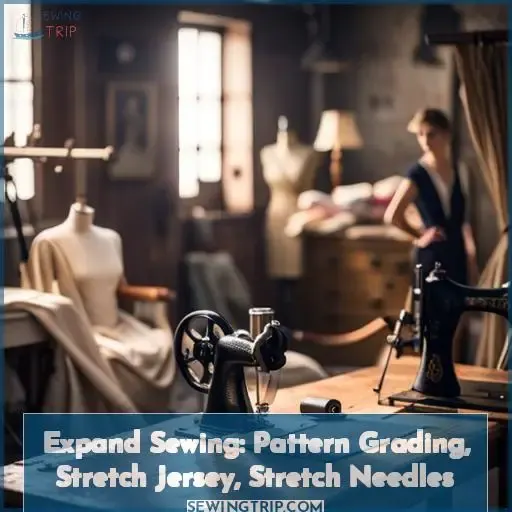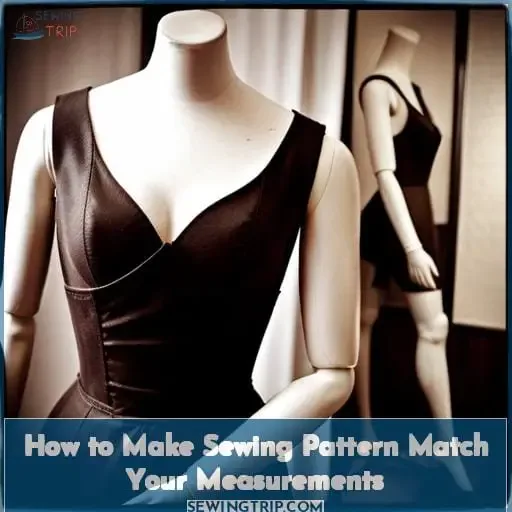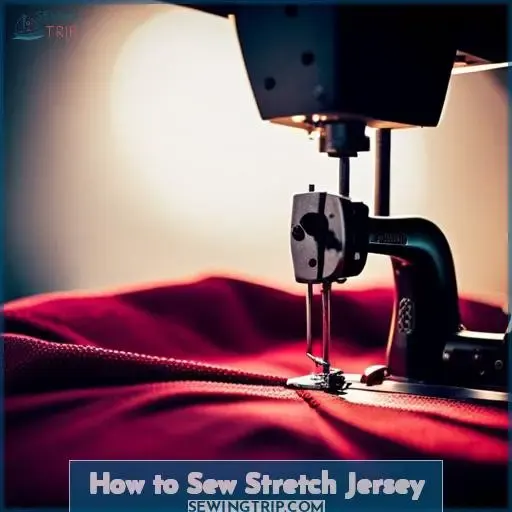This site is supported by our readers. We may earn a commission, at no cost to you, if you purchase through links.
 Are you looking to widen your sewing skills? If so, you’re in the right place! Here we’ll discuss pattern grading, stretch jersey and needles – all necessary tools for those who want to up their game when it comes to widening their sewing.
Are you looking to widen your sewing skills? If so, you’re in the right place! Here we’ll discuss pattern grading, stretch jersey and needles – all necessary tools for those who want to up their game when it comes to widening their sewing.
Pattern grading is a great way of taking an existing pattern and adjusting it without having to start from scratch.
We’ll also look at how best to work with stretch jersey fabric, as well as what a stretch needle is and when one should be used.
So grab your supplies because let’s get started on learning more about how to widen our sewing today!
Table Of Contents
Key Takeaways
- Pattern grading is a systematic way to resize sewing patterns for customized fits.
- Sewing mockups using muslin fabric enables fit adjustments before utilizing fashion fabric.
- Selecting the proper needles, thread, and cutting techniques are vital for sewing jersey material.
- Widening sleeves can be achieved via pattern alterations and employing elastic thread, gussets, or seam allowances.
What is Pattern Grading?
Making patterns bigger or smaller through grading lets you resize garments for a custom fit. Pattern grading is the process of systematically changing the proportions of a sewing pattern to create different sizes.
By enlarging or reducing pattern dimensions, you can scale a design up or down to achieve an ideal fit.
Common grading techniques include slash and spread, which enlarges patterns through strategic slashing and spreading.
Test resized patterns by sewing muslin mockups before cutting into fashion fabric.
Arm yourself with grading rulers, books, and courses on sizing. Fine-tune sleeves, waists, and more for a flattering custom fit.
How to Make Sewing Pattern Match Your Measurements
After finding your ideal size, double check your full measurements match those listed on the pattern envelope to guarantee it’ll fit your proportions.
- Compare your bust, waist, hip, and sleeve measurements to the finished garment measurements on the pattern envelope.
- For close fitting styles like dresses, note any ease added to the pattern and subtract that amount from your body measurements for an accurate match.
- Check the finished garment length and adjust your pattern if needed based on your height.
With some simple preparation, you can achieve a custom fit every time and bring your sewing visions to life. Taking a few extra minutes to match your measurements will create a perfect personalized pattern.
Then you can cut and sew with confidence, knowing the end result will fit you flawlessly.
How to Sew Stretch Jersey
Have you ever struggled with sewing knit or stretch jersey fabric? In this guide, we’ll cover the basics of working with jersey fabric, from choosing the right tools to sewing it on a standard machine, as well as some alternate methods if you still find it tricky.
First, you’ll want to select the proper needle and thread for sewing jersey. Choose a ballpoint or stretch needle, which glides between the knit fibers rather than piercing them. A 70/10 or 80/12 universal sewing machine needle will work well. As for thread, opt for polyester or nylon over cotton, as natural fibers like cotton have less stretch.
When cutting out your jersey pieces, use fabric scissors to prevent damaging the knit. Cut with the grain, not against it. If the fabric is very lightweight, you may want to use pins, clips or weights to hold the pieces in place as you sew to prevent stretching or distortion.
To sew, use a narrow zigzag stitch so the stitch has some give. Lengthen the stitch to 2.5-3mm for added flexibility. Attach a walking foot or other presser foot designed for knits to help feed the fabric evenly.
If you’re still struggling with skipped stitches, puckering seams, or tunneling, try these tips: Increase the needle tension slightly, use a stretch needle with a smaller eye, switch to a knit-specific thread like woolly nylon, or hand-baste seams before machine sewing.
With the right tools and techniques, you can master sewing with stretchy jersey knits.
Part 1: What is Jersey Fabric?
Mate, when stitching stretch jersey, you must tame the fabric tiger before it scratches your sewing plans. Jersey fabric is super stretchy and lightweight with a knitted construction. It flows nicely over curves and is used for t-shirts, dresses, activewear, and swimsuits.
To sew jersey, choose stretch stitches on your machine and use jersey needles. Also, match the thread to the fabric color. Finally, go slowly and pin often since jersey moves around. A firm presser foot helps feed the fabric.
Part 2: the Best Tools and Equipment for Stretch Jersey Fabric
Now that you understand jersey fabric, let’s dive into the best tools for sewing it successfully.
- A sewing machine with a zigzag stitch allows the seam to stretch with the fabric.
- Ballpoint or jersey needles easily glide through knits without snagging the threads.
- A serger or overlock machine neatly finishes seam edges to prevent fraying.
- Twin needles create professional narrow hems on knits.
- Washaway wonder tape temporarily bonds pieces together for easier sewing.
Having the proper equipment makes sewing stretch knits easy. Invest in high-quality needles, threads, and tools. With practice, you’ll create fantastic garments with wonderful drape and comfort.
Part 3: How to Sew Stretch Jersey on a Standard Sewing Machine
You’ll be shocked to learn that widening a sleeve is as simple as slashing and spreading your trusty pattern. For added ease, trace your sleeve pattern and add slash lines along the center and bicep. Gently spread the slashed areas to match your measured bicep circumference, anchoring the underarm.
A quick slash and spread grants you the power to customize any sleeve to suit your proportions. With this mastery of pattern adjustment, you gain the freedom to sew sleeves perfectly tailored to your measurements.
Part 4: Still Stuck? Try These Alternate Methods
Your heart sinks as you tug at the too-snug sleeves. But don’t lose hope – with a few clever tricks, you can widen those sleeves and save your creation:
- Use elastic thread in the bobbin for stretch.
- Insert gussets under the arms for more ease.
- Add princess seams to provide shaping.
- Cut a bigger seam allowance before sewing.
- Slice open the sleeve cap for extra width.
With some creative thinking and alternate techniques, you can modify any pattern for the perfect custom fit.
What is a Stretch Needle for Sewing?
When sewing with knits, stretch needles are a must-have tool. Using the wrong needle can ruin your project by causing skipped stitches, thread breaks, and runs in the fabric.
Stretch needles have a special scarf and tip designed to penetrate knit fabrics without distorting the loops and causing damage. The tip easily pierces the fabric while the scarf provides extra space for the thread to pass through without friction.
Stretch needles come in a variety of sizes to accommodate lightweight to heavyweight knits. Ballpoint and jersey/embroidery needles are two common types of stretch needles suited for sewing knits.
Investing in quality stretch needles ensures smooth sewing and professional-looking finished garments when working with elastic and stretchy fabrics. Follow the manufacturer’s recommendations and select the appropriate size needle for your fabric weight and thread type.
Change the needle often to keep the tip sharp. Proper stretch needles allow sewers to easily handle knits that would otherwise be difficult and temperamental to stitch.
Do You Need a Stretch Needle?
When working with stretchy fabrics like jersey, using a stretch needle can prevent skipped stitches and puckering. For example, switching to a stretch needle may help if you notice your T-shirt necklines becoming distorted when sewing knits.
| Needle Type | Uses |
|---|---|
| Ballpoint | Knits, jersey, spandex, sweater knits |
| Stretch | Super-stretchy fabrics like swimwear, dancewear |
| Universal | Most woven and knit fabrics |
Using the proper needle for your fabric type will help you get a smooth, professional finish when sewing stretchy fabrics.
Why Should I Use a Stretch Needle? What Happens if I Use a Regular Needle Instead?
Using the wrong needle can ruin your stretch fabrics, so opt for a stretch needle to prevent skipped stitches and holes. Its specialized scarf and point slide smoothly through knits without snagging the fabric, while regular needles lack this flexible tip.
As a result, regular needles shred and poke visible holes in delicate stretch fabrics. Choosing the proper needle prevents frustrations later on, saving you time and materials.
The Best Brand of Stretch Needles
Speaking of stretch needles, you’re probably wondering which brand is best for sewing knits and stretch fabrics. When it comes to stretch needles, Schmetz is my top choice. As the inventors of the stretch needle, Schmetz offers the widest range of sizes and features to suit any project.
Their needle book is indispensable for finding the perfect needle size – consult it when selecting needles between 70/10 and 90/14 for lightweight knits to 100/16 and 110/18 for heavier stretch fabrics.
With Schmetz stretch needles, you’ll experience smooth sewing, minimal skipped stitches, and less needle breakage. The quality and consistency of Schmetz stretch needles are unparalleled. While universal and ballpoint needles work in a pinch, for the best results, opt for Schmetz stretch needles on your next knit project.
Conclusion
The truth is, widening sewing isn’t as difficult as it may seem. With a few basic tools and techniques, you can expand your sewing projects to fit perfectly. Pattern grading helps you resize patterns to your measurements, while stretch jersey fabrics give you the flexibility to create fitted garments.
A stretch needle is the perfect tool to ensure your projects have enough give to be comfortable and move with you. All of these techniques can be combined to help you widen sewing and create garments that fit and flatter your shape.
Whether you’re a beginner or a professional, understanding how to widen sewing can help you create beautiful garments.











